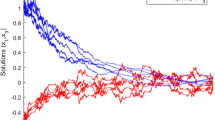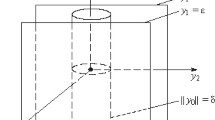Abstract
In this paper, critical stability and critical stabilization for discrete stochastic systems with both state and control dependent noise are discussed via the spectrum technique. The Popov-Belevitch-Hautus (PBH) criterion for exact observability in a discrete version is presented. As applications, some interesting results on a class of generalized Lyapunov equations (GLE), unremovable spectra and discrete generalized algebraic Riccati equation (GARE) are obtained. Finally, the problem of assigning the spectra of discrete stochastic systems in a specified disk is considered and some numerical examples are given to demonstrate our results.
Similar content being viewed by others
References
G. Y. Tang, H. Y. Sun, and H. P. Pang, “Approximately optimal tracking control for discrete time-delay systems with disturbances,” Progress in Natural Science, vol. 18, no. 2, pp. 225–231, February 2008.
L. J. Qian and Z. Gajic, “Variance minimization stochastic power control in CDMA systems,” IEEE Trans. on Wireless Communications, vol. 5, no. 1, pp. 193–202, January 2006.
H. S. Zhang, X. Lu, W. H. Zhang, and W. Wang, “Kalman filtering for linear time-delayed continuous-time systems with stochastic multiplicative noises,” International Journal of Control, Automation, and Systems, vol. 5, no 4, pp. 355–363, August 2007.
N. Berman, G. Ben, and U. Shaked, “Robust L ∞-induced filtering and control of stochastic systems with state-multiplicative noise,” IEEE Trans. on Automatic Control, vol. 55, no. 3, pp 732–737, March 2010.
W. H. Zhang, Y. L. Huang, and H. S. Zhang, “Stochastic H 2/H ∞ control for discrete-time systems with state and disturbance dependent noise,” Automatica, vol. 43, no. 3, pp. 513–521, January 2007.
J. L. Willems and J. C. Willems, “Feedback stabilizability for stochastic system with state and control dependent noise,” Automatica, vol. 12, no. 3, pp. 277–283, May 1976.
R. Z. Has’minskii, Stochastic Stability of Differential Equations, Sijtjoff and Noordhoff, Alphen, 1980.
W. H. Zhang, H. S. Zhang, and B. S. Chen, “Generalized Lyapunov equation approach to statedependent stochastic stabilization/detectability criterion,” IEEE Trans. on Automatic Control, vol. 53, no. 7, pp. 1630–1642, July 2008.
W. H. Zhang and B. S. Chen, “On stabilizability and exact observability of stochastic systems with their applications,” Automatica, vol. 40, no. 1, pp. 87–94, January 2004.
W. H. Zhang and L. H. Xie, “Interval stability and stabilization of linear stochastic system,” IEEE Trans. on Automatic Control, vol. 54, no. 4, pp. 810–815, April 2009.
T. Damn, Rational Matrix Equations in Stochastic Control, Springer, Berlin-Heidelberg, 2004.
M. D. Fragoso, O. L. V. Costa, and C. E. de Souza, “A new approach to linearly perturbed Riccati equations arising in stochastic control,” Applied Mathematics and Optimization, vol. 37, no. 1, pp. 99–126, June 1998.
H. Y. Sun, M. Li, and W. H. Zhang, “Stability and stabilization of stochastic systems with multiplicative noise,” International Journal of Control, Automation and Systems, vol. 9, no. 2, pp. 211–217, April 2011.
K. Furuta and S. B. Kim, “Pole assignment in a specified disk,” IEEE Trans. on Automatic Control, vol. 32, pp. 423–427, 1987.
W. H. Zhang, J. E. Feng, B. S. Chen, and Z. L. Cheng, “On spectral assignment and detectability of linear stochastic systems,” Proc. of American Control Conference, pp. 386–387, 2005.
J. E. Feng, S. Y. Xu, and W. H. Zhang, “H ∞ output feedback control with spectrum constraints for uncertain stochastic systems,” Circuits, Systems, and Signal Processing, vol. 26, no. 2, pp. 193–214, April 2007.
Z. D. Wang and Z. Guo, “Circular pole and variance-constrained design for linear discrete system,” Control Theory and Applications, vol. 14, pp. 105–111, 1997.
Y. L. Huang, W. H. Zhang, and H. S. Zhang, “Infinite horizon linear quadratic optimal control for discrete-time stochastic systems,” Asian Journal of Control, vol. 10, no. 5, pp. 608–615, September 2008.
E. D. Sontag, Mathematical Control Theory: Deterministic Finite Dimensional System, Springer, New York, 1990.
A. El Bouhtouri, D. Hinrichsen, and A. J. Pritchard, “H ∞-type control for discrete-time stochastic systems,” International Journal of Robust and Nonlinear Control, vol. 9, no. 13, pp. 923–948, 1999.
Author information
Authors and Affiliations
Corresponding author
Additional information
Recommended by Editorial Board member Young Soo Suh under the direction of Editor Young Il Lee.
This work was supported by the National Natural Science Foundation of China (Grant No.60874032), the Key Project of Natural Science Foundation of Shandong Province(Grant No. ZR2009GZ001) and the Specialized Research Fund for the Doctoral Program of Higher Education of PR China (Grant No. 20103718110006). The authors would like to thank the Editor Young Il Lee and Editorial Board member Young Soo Suh.
Huiying Sun received her M.S. degree from Qingdao University of Science and Technology, and her Ph.D. degree from the Ocean University of China, in 2004 and 2007, respectively. She is currently an associate professor of Shandong University of Science and Technology. Her main research interests include optimal control and linear stochastic control.
Meng Li received his Bachelor degree majoring in Communication Engineering from Shandong University of Science and Technology, China, in 2008. Since September 2008, he has been pursuing his M.S. degree in the same University. His main research interests include linear stochastic control and stochastic differential games.
Weihai Zhang received his M.S. degree from Hangzhou University, and his Ph.D. degree from Zhejiang University, Hangzhou, China, in 1994 and 1998, respectively. From August 1998 to May 2001, he worked at Shandong Institute of Light Industry as an associate professor. He was a postdoctoral researcher from May 2001 to July 2003 at National Tsing Hua University, Hsinchu, Taiwan. He rejoined Shandong Institute of Light Industry in August 2003 as a professor. From November 2006 to May 2007, he visited Nanyang Technological University as a visiting research scientist. He is currently a professor of Shandong University of Science and Technology. His research interests include linear and nonlinear stochastic optimal control, robust H infinity control and stochastic stability.
Rights and permissions
About this article
Cite this article
Sun, H., Li, M. & Zhang, W. Critical stability and stabilization of discrete-time stochastic systems and its applications. Int. J. Control Autom. Syst. 9, 1028–1036 (2011). https://doi.org/10.1007/s12555-011-0602-8
Received:
Revised:
Accepted:
Published:
Issue Date:
DOI: https://doi.org/10.1007/s12555-011-0602-8




